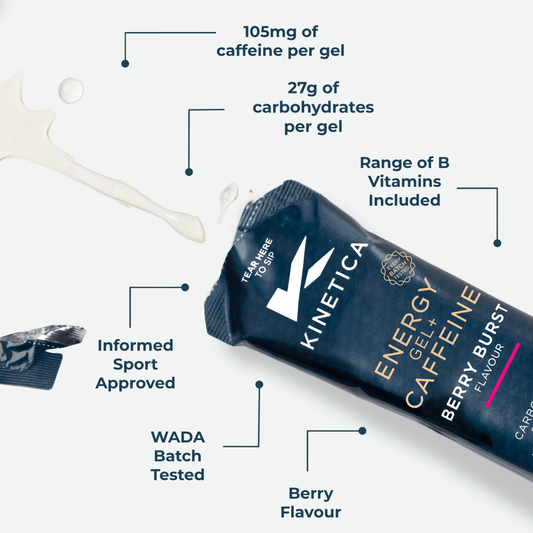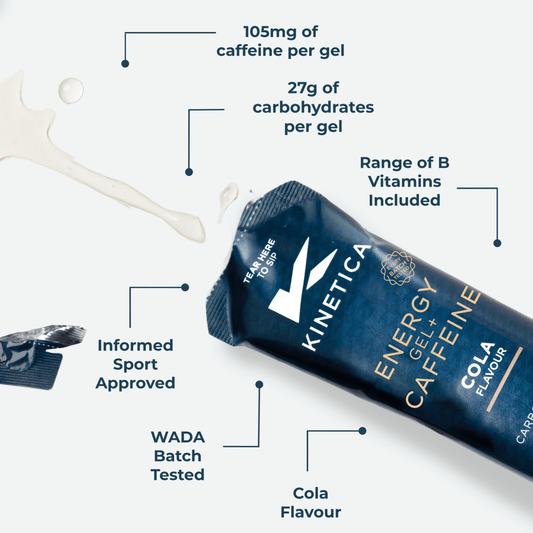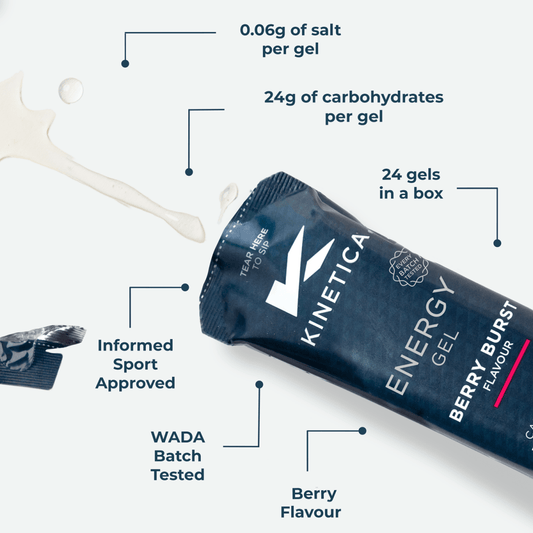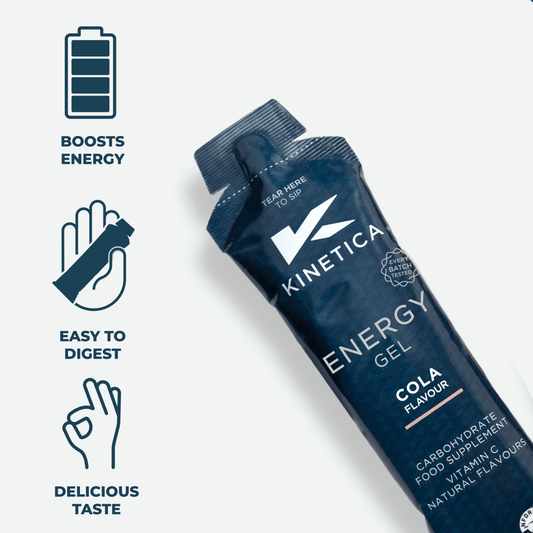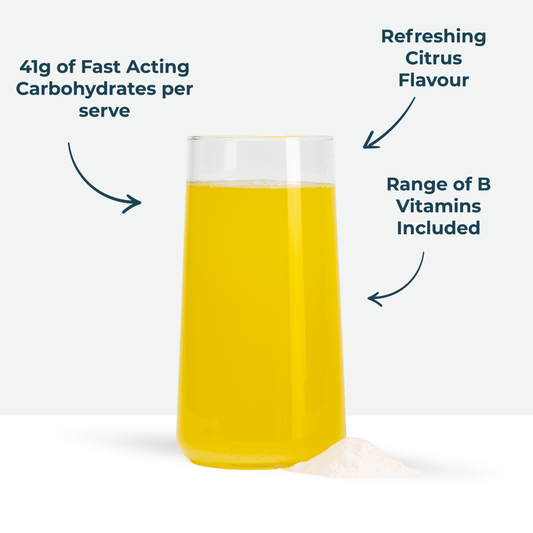What Are Energy Gels and How Can They Help You?

Whether you’re a seasoned endurance runner, play sports like rugby or tennis, or regularly train for hours, you’ll know how vital keeping your energy levels up is to maintain your performance.
But, considering there’s no time to eat a full meal in the middle of training, how can you take in energy to replace what you’ve lost and maintain performance? We have a solution for you: energy gels.
In this guide, we’ll answer some of the most common questions around energy gels, including: what are energy gels, what are the advantages of taking them, and how can they help your athletic performance?
What are energy gels?
First and foremost then, is the question of what are energy gels?
As the name suggests, an energy gel is a sports supplement designed to give your body the nutrients it needs for an extra burst of power. The gel form ensures that they’re a quick and easy way to increase your energy intake during endurance activities.
At Kinetica Sports, we have a great selection of energy gels and supplements for you to choose from depending on the type of sports nutrition that you’re looking for.

Shop our Energy and Endurance range today!
How do energy gels work?
So how do energy gels work?
The short answer is that energy gels (or running gels as they’re sometimes known), contain a concentrated amount of carbohydrates which provide energy and maintain blood glucose levels during exercise, and prevent fatigue from setting in.
But, let’s look at this in a little more detail. We first need to explore what carbohydrates are and how the body uses them.
One of the main three macronutrients alongside fats and proteins, carbohydrates are an energy source for the body (amongst other things). Carbohydrates itself is an umbrella term to cover fibres, starches, and simple sugars called mono- or disaccharides, and complex sugars called oligosaccharides and polysaccharides1.
It’s these simple sugars, like fructose and glucose, that are the most relevant for energy gels. Simple and complex carbohydrates (or sugars) are vital for cellular energy production – as, alongside oxygen, sugars are a key component of aerobic and anaerobic respiration2. Smaller molecules, like monosaccharides, are easier for the body to absorb and use, but longer chains are still important to provide a more sustained energy boost. Taking an energy or running gel allows the body to supplement its own energy supply, slowing the onset of fatigue and ensuring you don’t deplete your reserves – allowing you to continue towards your exercise goals each session.

Buy now – Kinetica Sports Energy Gel
At Kinetica Sports, we use a combination of simple and complex carbohydrates to provide you with the boost you need to maximise your performance and achieve your exercise goals. Our Energy Gels contain 24g of carbohydrates, including maltodextrin and fructose, which have been proven to improve athletic performance by increasing the exogenous carbohydrate oxidation (where the body uses external sources, rather than depleting internal glucose levels)3 and helping to maintain your blood glucose levels.
Do energy gels have caffeine?
Whether or not an energy gel contains caffeine depends entirely on the type of energy gel you buy. Here at Kinetica for example, while our regular energy gels are caffeine free, we do have a selection of Energy Gel + Caffeine gels for you to choose from. With 105 mg of caffeine per serving, our caffeinated energy gels are perfect for athletes looking for a quick mental and physical boost.

Buy now – Energy Gel + Caffeine
Caffeine is a stimulant that can help to improve focus, and help you feel like you have more energy. But, unlike carbohydrates, caffeine doesn’t directly provide the body with ingredients to make energy. Instead, caffeine stimulates the brain and nervous system to give you that ‘wide awake’ feeling. It also has a vasodilatory effect – which is where your blood vessels widen, allowing more blood to be transported around the body4.
When it comes to choosing the best energy gel for your training needs, the inclusion of caffeine is a largely personal preference. Whilst studies suggest that ingesting caffeine can improve your athletic performance5; if you are sensitive to caffeine, or are working out/taking an energy gel in the evening, you may want to choose a non-caffeinated supplement to avoid disrupting your sleep.
The advantages of taking energy gels
Now you know what energy gels are, and how they work in the body, let’s look at some of the advantages to incorporating energy gels into your training routine and nutritional plan.
Reduced risk of nausea
One of the main advantages of choosing a running gel is that they’re a lot easier on your digestion than other sources.
For example, one study explored the differing impacts of carbohydrate drinks, gels, bars, and a mix on gut comfort and performance. They found that energy gels were comparatively better than bars in terms of nausea, cramps and fullness, as well as with regards to peak power during endurance exercise6.
Top tip: one way to make your energy gel softer on the stomach is to make sure you drink plenty of water. This helps to settle your stomach after the intense amounts of carbohydrates per serving.
If you’re running a marathon or playing in a sports match, the last thing you want is for your energy supplement to give you a cramp, or make you feel uncomfortable for the rest of the event. Energy gels are gentle on the stomach whilst still providing you with the energy you need to succeed.
Fast-acting
Because of their shorter chain structure, being limited to one or two molecules, mono- and disaccharides (sugars) like fructose are easier for the body to absorb quickly. This is what provides you with a boost in available energy you need during exercise.
Compared to other sources, energy gels provide you with a lot of carbohydrates in a short space of time – so you can concentrate on maintaining performance and achieving your goals.
Convenience
The majority of our dietary carbohydrates come from foods like fruits and vegetables, starches like potatoes and bread, and pulses like beans and lentils. However, eating these during endurance exercises isn’t exactly practical.
Not only can large meals sit heavily and make you feel bloated during digestion, you don’t have the time that eating food requires. Instead, energy gels are a convenient way to introduce the carbohydrates you need in a small, easily-consumed dose.
With a 70 g pack side, our Energy Gels are small and lightweight – perfect for runners and cyclists to use on the go; or for sports matches, they’re easy to slip into your training bag to have during the game.
Top tip: as with any sports supplement, make sure you take a new energy gel during training, rather than straight through to competition. This gives you time to adjust and work out how best you can incorporate it into your diet.
Additional nutrition
Alongside giving your body the fuel it needs to compete or train, energy gels can have additional ingredients to support your performance needs.
As we mentioned above, some energy gels are caffeinated to give you an extra boost of focus and wakefulness. Others may have added electrolytes to improve fluid retention and help to prevent you feeling dehydrated during exercise.
At Kinetica Sports, we ensure that every ingredient within our supplements is there for a reason. Our Energy Gels, for example, contain 0.06g of salt to help you maintain your hydration. Our formula also has 24 mg, or 30%, of your recommended daily vitamin C intake to support your overall health as you work on achieving your performance goals.
When to take energy gels
There is a lot of advice around when to take energy gels, and some of this will have to rely on your personal exercise plan. But, we do have a few tips which can help you figure out when is best for you.
- Take your first energy gel at least 15 minutes before you exercise to allow it time to kick in (although this may be stretched to an hour before depending on your event).
- For longer events, many take a running gel approximately every 30 minutes to maintain blood glucose levels.
- Experiment during training to learn what times are best for you and create an evidence-based supplement plan.
Kinetica Sports: you have the why, we have the how
At Kinetica Sports, we understand that everyone has a different ambition when it comes to exercise. Whether you’re an ultra-marathon runner, a professional rugby star, or even a weekend warrior striving for your next PB, your supplements should be there to support your performance and give you the means to reach your goals.
To help you reach your potential, we never include ‘filler’ ingredients in our supplements – everything has a purpose. In addition to this, all of our energy gels (and more) are rigorously tested to make sure they are WADA compliant under the exacting Informed Sports testing standards.
All of this means that you can train with confidence when you buy supplements from Kinetica Sports. Discover our ranges today, including Protein and Collagen to find the best supplements for you.
If you’re interested in learning more, check out our Kinetica Sports Blogs to find plenty of helpful resources, guides, and even recipes.


